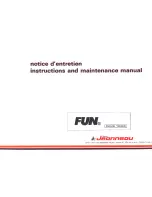
Section B
Page 1
378 Vista™ Owner’s Manual
™
378
B - 1
GENERAL
As the owner/operator of the boat, you are responsible
for assuring that all required safety equipment is aboard.
You should also consider supplying additional equipment
as needed for your safety and that of your passengers.
Check state and local regulations and call the U.S. Coast
Guard Boating Safety Hotline at 1-800-368-5647 for in-
formation about required safety equipment.
A. Required Safety Equipment
Most of the safety equipment required by federal regu-
lations is provided as standard equipment. Personal
Floatation Devices (life jackets) must fit the person wear-
ing it. If local regulations require additional equipment,
it must be approved by the U.S. Coast Guard (USCG).
Minimum requirements include the following:
• Personal Floatation Devices
• Visual Distress Signal
• Bell or Whistle
• Fire Extinguisher
• Navigation Lights
NOTICE
As the owner/operator of the boat, you are re-
sponsible for assuring that all required safety
equipment is aboard and meets the boating
regulations as prescribed by both federal and
local authorities in your area.
B. Personal Floatation Devices (PFDs)
Federal regulations require that you have at least one
Coast Guard approved personal floatation device (PFD)
for each person in a recreational boat. You should not
use your boat unless all PDFs are in serviceable condi-
tion, readily accessible, legibly marked with the Coast
Guard approval number, of an appropriate size (within
the weight range and chest size marked on the PDF)
for each person aboard.
A PFD provides buoyancy to help keep your head above
the water and to help you remain in a satisfactory posi-
tion while in the water. Body weight and age should be
considered when selecting a PFD. The buoyancy pro-
vided by the PFD should support the person’s weight in
the water.
The size of the PFD should be appropriate for the
wearer. Body weight or chest size are common meth-
ods used to size PFDs. It is your responsibility to en-
sure that you have the proper number and types of
PFDs on board and that your passengers know where
and how to use them.
C. PFD Types
Five types of PFDs have been approved by the U.S.
Coast Guard. The PFDs are described as follows:
PFD Type 1, Wearable
(Figure B1) has the greatest
required buoyancy. Its design allows for turning most
unconscious persons in the water from face down po-
sition to a vertical or slightly backward, face-up posi-
tion. It can greatly increase the chances of survival.
Type 1 is most effective for all waters, especially off-
shore when rescue may be delayed. It is also the most
effective in rough waters.
Figure B1: Type I, Wearable
PFD Type II, Wearable
(Figure B2) turns its wearer in
the same way as Type I, but not as effectively. The
Type II does not turn as many persons under the same
conditions as a Type I. You may prefer to use this PFD
where there is a probability of quick rescue such as in
areas where other people are commonly involved in
water activities.
Figure B2: Type II, Wearable
SAFETY & SAFETY EQUIPMENT
Summary of Contents for 378 VISTA
Page 1: ...378 VISTA OWNERS MANUAL ...
Page 51: ...Section C Page 7 378 Vista Owner s Manual 378 Figure C5 Navigational Aids Chart ...
Page 73: ...Section G Page6 378 Vista Owner s Manual 378 Figure G6 Tie Bar 47 1 4 Tiller Arm Assembly ...
Page 166: ...Locator Drawing Page 1 378 378 VISTA LOCATOR DRAWING 378 Vista Owner s Manual ...
Page 196: ... Page 30 CLARION AMPLIFIER APX400 4M CONNECTIONS SETTINGS Electrical Schematics ...
Page 199: ......
Page 200: ......
Page 201: ...A G E N M A R C O M P A N Y P A R T 0 9 0 2 7 4 4 ...
















































